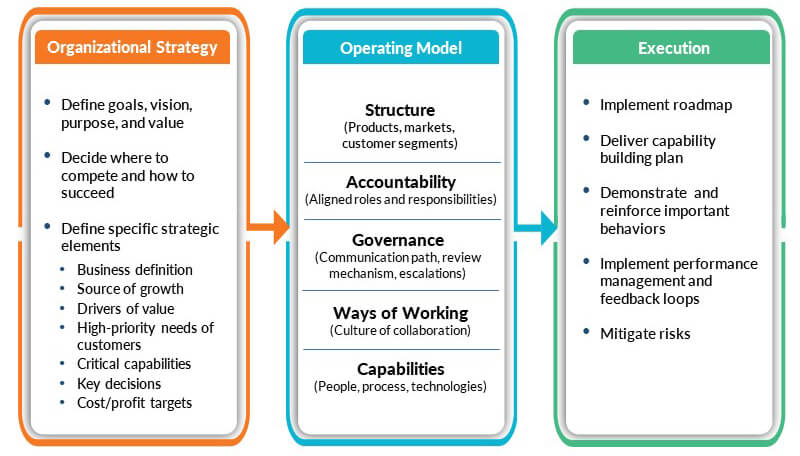An efficient and effective IT operating model is crucial for any successful Application Managed Services (AMS) delivery. A well-designed operating model clearly defines how to utilize spends optimally by making the best use of available resources while maintaining an ideal balance with process and technology for maximum ROI with best-in-class integration with the available functional teams. This is important to get an edge during challenging times like the COVID-19 pandemic.
This blog discusses new paradigms for IT operating models using NextGen technologies and highlights how this modernization can bring about a remarkable difference over traditional IT operating models. It also enables catering to rapidly changing customer demands, technological advancements, differing form factors, and portability. Some of the questions that we are looking to address here include:
- What is an operating model?
- What is a traditional operating model and what are its building blocks?
- What are the limitations and challenges that make you think about an IT operating model from a different perspective?
- What is NextGen IT operating model and how is it different from a traditional operating model?
What is an Operating Model?
An operating model is the blueprint of an organizational business vision and is aligned with strategic objectives for cost-efficient application management. It depicts collaboration, interaction and integration between organizational capabilities, internal service groups/ functions, and external providers at the strategic and operational levels. Its purpose is to be a single view of how services are delivered within the organization.
For this blog’s purposes, we will restrict our view to the IT operating model (not the overall business operating model, which has a much larger scope and plays an essential role in how the IT operating model is organized).
How the IT operating model aligns with the rest of the business is a crucial determinant for the model’s success, both culturally and from a value-creation point of view. It needs to be understood if the model promotes agility and growth or is stifling innovation and acting as a barrier to organizational development.
An IT operating model is no longer a simple structure where some strategic contractors augment internal IT teams. The model is somewhat complicated for today’s organizations and involves a bevy of stakeholders – both internal and external. Additionally, the role of the business teams in the IT operating model is becoming prominent and therefore we can observe the alignment towards business-focused structures.
The Building Blocks of a Traditional IT Operating Model
A traditional operating model depicts core business capabilities and support groups/ functions aligned with different lines of business (verticals), internal and external providers, and strategic (expansion, presence, market, global reach) and operational levers (process, technology, changes for the operating model, organizational structure). It represents a unique set of capabilities suitable for delivering application management services aligned to business strategies, core capabilities of the internal line of businesses (LoB), and interactions with external drivers/ providers. It takes shape through choices in the following five areas of the operating model:

Traditional IT Operating Model and its Challenges
In the traditional IT operating model, the IT and business vision may not be fully aligned with each other. The business has a pre-notion that domain-related demand and supply responsibility lies primarily with the IT function. While the IT function is inclined more towards technical aspects and relies more on the technical competencies and scale of operations, the business (LoBs) serves customers in a coordinated way. However, business functions in an isolated manner and each LoB follows its own processes. This leads to the need for process standardization and improvements in the working between business and IT delivery.
Shifting from Traditional to NextGen IT Operating Model
The required speed of change and large-scale evolutions in digital technologies force enterprises to rethink their strategy for application IT operation and service management. The pace of disruption is set to increase in the coming years. While in the immediate term it is acknowledged as the response to COVID-19, most CIOs are now accepting modernization as the only way to thrive in the future.
In recent years, we have witnessed numerous emerging technologies like enterprise systems, mobile endpoint devices and apps, big data analytics, social robotics, sensors and IoT, blockchain, smart contacts, cloud computing, etc. These are not only changing how technology is being delivered but also resulting in changes to the entire business models. Therefore, organizations are now under pressure to rethink their whole operational strategy rather than just the technology front.
All this has led CEOs/CIOs to look for better ways to integrate their IT services delivery into the larger business context and made IT a real differentiator. This change can only be possible through innovative forms of collaboration between business and IT. A suitable change in the existing IT operating model is the key to ensuring speed, flexibility, and better time to market and operational optimization. Most traditional operating models are incapable of handling continuous change, whereas constants always change with variables. For some sectors, these trends’ impact is so significant that companies may need to change their core business models to survive. The following infographic shows how the IT roles were aligned to collaborate with each other in both the traditional and new IT operating model.

NextGen Operating Model – The New Way of Operations
CIOs are now required to re-examine their Target Operating Model (TOM) — how they configure operations to execute business technology strategies. This is not a simple task as organizations will need to strike the right balance between a range of difficult choices – like security versus openness, proprietary versus shared, vanilla versus best-of-breed, reliable and predictable versus fast failure, etc. They will need to customize TOM to meet the current organizational needs while anticipating future digital information and technology requirements. Most critically, they will need to optimize TOM to capture both short-term and long-term benefits from application management.
The NextGen operating model for application managed services intertwines both business and IT cohesively by leveraging these digital technologies. It enables more decentralized, dynamic, and agile changes driven by smaller and focused teams, not only from IT but also operations, finance, marketing, sales, and even business user communities. Some of the maturing trends carving the NextGen operating model include agile, DevOps, cloud ecosystem, BYOD, open-source, API platform, social media and mobility, and PESTEL (Political, Economic, Sociological, Technological, Environmental, and Legal).
Key Building Blocks of the NextGen Operating Model

This model focuses on flexibility and customized services based on customer needs to keep pace with the current trend of continuous technological changes. Emerging technologies like cloud, mobility, and automation can bring in more significant opportunities while adding agility and speed. With the help of digital technologies, social collaboration tools, mobile channels and business analytics, the customers can realize digital transformation in their business in a shorter period and enable seamless connectivity between virtual and physical worlds, thereby enhancing customer experience.
Further, PESTEL analysis can help organizations rethink the role, structure and processes of critical functions such as IT risk & compliance and evolve continuously. It will also help look at many different and influential application management factors affecting an operating model’s success. But the model should be resilient to handle PESTEL analysis or factors.
For the successful transformation of an IT operating model to a NextGen operating model, an organization needs to change its thinking. It needs to redesign the IT operating model to accelerate digital business and align itself with business, IT, and technology to ensure strong leadership commitment for
- Continuous adaption of technological change
- Emphasis on modern delivery (agile, cloud, automation, CI/CD, DevOps)
- Continuous innovation
Strategizing the change to new ways of operating in a phased manner is possible by taking small steps with incremental investments. To drive the NextGen operating model, a right mix of new approaches and capabilities should be developed.
NextGen Operating Model – Aligned with Business, IT, and Technology

NextGen Operating Model – Setting up New Norms
- Speed and agility for faster time to market is the key. The two approaches with the highest potential to provide speed and agility in delivery are agile/Scrum and DevOps. Both enable faster feedback and continuous learning. The traditional walls between development vs business, and between development vs operation teams are eliminated through alignment of business and technologies. Agile and DevOps fix it.
- The boundaries between business and IT are diminishing. With companies relying more and more on digital technologies and digital businesses, the ways of working are being redefined. This is bridging gaps in the functioning of business and IT, which were otherwise operating in silos. With the differences fading away, the business and IT roles have become interchangeable where some technology skills and a certain level of tech fluency are required. This ultimately results in the convergence of IT and business.
- There is a high dependency on digital, AI and robotics. This requires a workforce having new expertise and competencies. A large volume of manual work is getting automated through user self-provisioning, data automation, DevOps, and cloud. This digital transformation trend in business seeks specialists rather than technology consultants. Some of the emerged specialist skills are UX designers, visual designers, and data scientists. For new delivery models (cloud), there will be a need for more mature vendor management.
- In addition to affecting the IT Operating Model’s visible aspects like workforce, applications, enterprise systems and underlying infrastructure, this also impacts the other elements such as vision, values, culture and leadership. Culture and behavior do not change just by expecting the workforce to be more digital.
- IT delivery through cloud transformation is becoming prominent. It enables on-demand self-service, measured services, pay-per-use, any quantity any time, resource pooling model and availability over the internet. The three main offerings of the cloud are IaaS (Infrastructure as a Service), PaaS (Platform as a Service), SaaS (Software as a Service). This enables horizontal and vertical scaling on demand, faster and data-driven architectures, automation opportunities through virtualization, etc. Moving to the cloud, however, is not just lift and shift. It requires a larger effort to make an application work on the cloud.
Benefits of the NextGen Operating Model
The NextGen IT operating model can help in cost reduction, high availability, flexibility to reduce and expand, minimize risks, and improve time to market. Though this may not entail significant changes from a tactical and strategic governance perspective, the modes of communication may change when deploying an ‘information-push’ approach. With NextGen operating model, the IT, business and operations have become increasingly interoperable.
Getting Future-Ready
A shift from traditional to a NextGen operating model brings in cross-functional (business and IT) agile teams and product owners in critical roles. Technology is organized closer to/ embedded in the business (especially application development and maintenance). A center of excellence and innovation labs help build and foster new technology capabilities that can support outside the model. Cloud computing creates a new reality where business units can adopt cloud solutions quickly without even being engaged. Accommodating changing technologies, ways of operating, and adapting to changes is a continuous journey. Though the journey to shift from the traditional way of working to Nextgen is on, it will take a few years to initiate, evolve and master.
Post the COVID-19 pandemic, we are witnessing a paradigm shift already in the ways of operating w.r.t IT infrastructure needs, changes in processes, work from home model, applications enhancement, monitoring aspects, changes in governance model, new modes of communication, facilities management (HR, office within homes, logistics), customer experience and many more. And implementing an apt target operating model will make your application management efforts more efficient. We are already witnessing a change in the ways of working with more of virtual connect and digital technologies to accomplish our work. Digital acceleration and technology innovations are here to stay and motivate success.



















